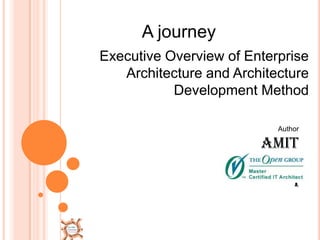EA - A Journey
- 1. A journeyExecutive Overview of Enterprise Architecture and Architecture Development Method AuthorAmit Nandi
- 2. Enterprise Architecture framework and Architecture development MethodUsing TOGAF 9, FEA, FSAM, TEA,COBIT, ITIL, and Existing Enterprise architecture2www.thesmeconsortium.com
- 3. 3www.thesmeconsortium.comIn most organizations architecture work stop at the end of creation phaseArchitecture
- 4. Establish EA programEnterprise CapabilitiesDefine FrameworkDefine, Prioritize SegmentsChoose toolsDevelop GovernanceObtain ApprovalGovernance(COBIT ITIL Existing Governance)4www.thesmeconsortium.comTOGAF 9Existing Architecture
- 5. Define VisionDefine ScopeGap AnalysisRoad MapEstablish ProjectsIdentify StakeholdersObtain Sponsor ApprovalGovernance(COBIT ITIL Existing Governance)5www.thesmeconsortium.comTOGAF 9Existing Architecture
- 6. Define LoB PRMDefine LoB BRMPopulate As-is BRM Populate To-be BRMConduct gap analysisConduct impact analysisPopulate PRM indicatorGovernance(COBIT ITIL Existing Governance)6www.thesmeconsortium.comTOGAF 9Existing Architecture
- 7. Define LoB - SRM DRMPopulate As-is Populate To-be Conduct gap analysisConduct impact analysisPopulate PRM indicatorGovernance(COBIT ITIL Existing Governance)7www.thesmeconsortium.comTOGAF 9Existing Architecture
- 8. Define LoB TRMPopulate As-is TRM Populate To-be TRMConduct gap analysisConduct impact analysisPopulate PRM indicatorGovernance(COBIT ITIL Existing Governance)8www.thesmeconsortium.comTOGAF 9Existing Architecture
- 9. Business Context System Context ModelUse Case ModelUser Profile Non Functional RequirementsArchitecture DecisionsArchitecture OverviewComponents ModelOperational ModelGovernance(COBIT ITIL Existing Governance)9www.thesmeconsortium.comTOGAF 9Work products developed in Phase A through Phase DExisting Architecture
- 11. Road Map
- 12. ProjectsGovernance(COBIT ITIL Existing Governance)Existing Architecture










